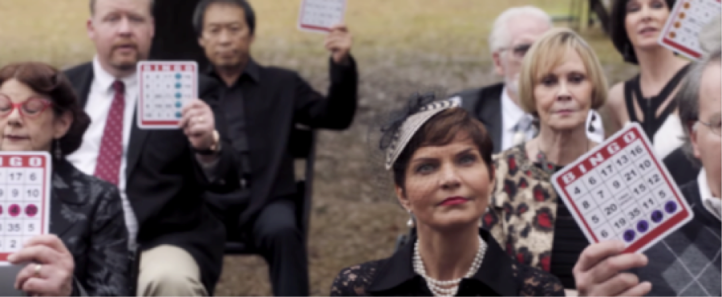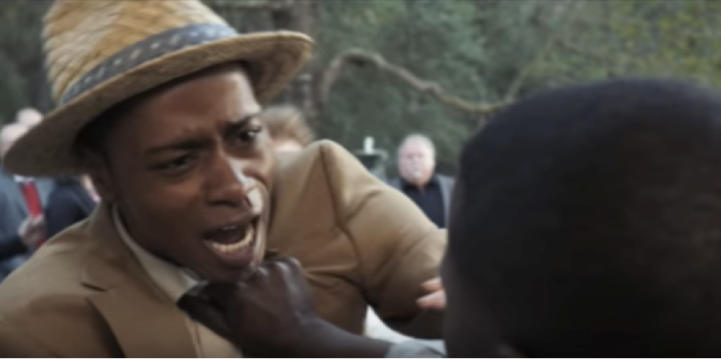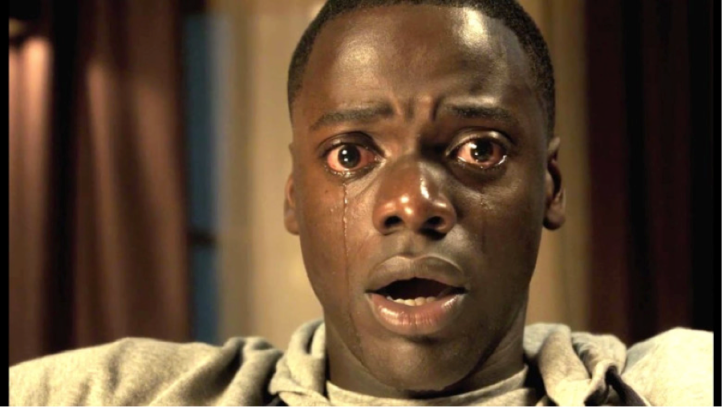
Spoiler Alert – I’m definitely going to be ruining some important details from Jordan Peele’s Get Out if you read this without having seen the film.
We liberal White folks sure do LOVE Jordan Peele’s smash hit Get Out. In a recent conversation with friends, one White person remarked that it’s a “genius use of fiction” that highlights the realities of White liberal racism.
And that’s true. But in the context of the brutal history of Whiteness, the plot of Get Out is not exactly a far fetched idea (for more on the construction and history of Whiteness, see the work of Battalora, Du Bois, Leonardo, Painter, and Rodeiger). And I wonder to what degree that is lost of us as White people as we flock to see the film.
After all, the film depicts a particular type of violence committed by White people against Black lives and bodies. In the film, Black people are being kidnapped by White liberal suburbanites in order to lobotomize them, steal their bodies, and have a White brain and consciousness take over the body – effectively rendering the White body snatcher immortal.
This is a medicalized violence to benefit the longevity of White health. And that’s not exactly a new or fictive concept.
As we watch the film, White audiences ought to consider the ways that many developments in Western medicine have been achieved through a similar process. For as long as Western medicine has been a reality, Black bodies (as well as the bodies of other people of Color) have been experimented upon without consent to advance the field to the benefit of White people.
What we now know as gynecology exists because a White man experimented brutally on the bodies of enslaved Black women – Anarcha, Lucy, and Betsy – who are only now being called the “mothers of modern gynecology” in a somewhat ironic twist of feminist language (since so much of feminism relies on the presumption that motherhood should fundamentally be a choice for women, yet these women were given no choice).
Advancements in tumor removal, treatment of injuries, and responses to birth “defects” (to use the common but ableist language) have all resulted from White experimentation on Black enslaved bodies. More widely known are the Tuskegee experiments to understand and development treatments for syphilis conducted by the U.S. federal government until the 1970s without the proper consent of Black participants. I could go on and on…
When Saidiya Hartman speaks of the “afterlife of slavery,” whereby the violence of slavery lives on in new and renewed forms of racial violence, I can’t help but think that Get Out offers us a glimpse through narrative into the medicalized violence of our past.
My point is that within the context of this history, Get Out is just barely a fiction. As such, the film exists as a powerful piece of counterstory and Racial Realism in the tradition of Critical Race Theory. What is powerful about counterstory and Racial Realist narrative, though, is that it ought to make us as White people profoundly uncomfortable, for these fusions of art and scholarship have the power to turn the lens on how White people are complicit in the ongoing violence of racial oppression.
So as I watched the film and as I watched the majority-White audience file out of the theater, I couldn’t help but wonder:
What are we as White people getting from this film? How does Get Out serve us?
Sure, some White folks have called the film “racist” and “anti-White” (predictably speaking to our usual yet profound lack of understanding of racism). But by and large, the film has been received an incredible response from White critics (ain’t nothing Whiter than Terry Gross gushing about the film with it’s creator) and audiences (I mean, look at the Rotten Tomatoes score for fucks sake). The film is clearly serving some kind of purpose for White folks. And as Derrick Bell makes clear, White people tend not to be supportive of anything that challenges Whiteness unless we have a clear interest in doing so. So what is our interest in the film?
Well, I see the film as serving three of the functions that are necessary to the continued functioning of the modern White racial (sub)conscious: a signal that we are, in fact, the “good’ White people, an opportunity to enjoy and consume Black suffering and death (while also lauding a Black hero), and an opportunity to emotionally distance ourselves from the truths of the brutality of Whiteness.
1. “I’m One of the Good Ones!”

The first and simplest of the three things I argue that we as White folks get out of our very public lauding of the film relates to our need to be seen as “good.” Many authors have talked about the need White people often feel to feel good about being White without doing anything to address our complicity in interpersonal racism or systems of racial oppression (see Applebaum, Frankenburg, Matias, Tatum, and Tochluk).
This trend has taken on a whole new dimension with the advent of social media, which allows us as White people to signal our support for racial progress or to distance ourselves from “bad” White people without actually doing anything to destabilize Whiteness as a system of oppression or to change our daily investments in Whiteness. Of course, there’s always more that we as White people can do to address racism, but I definitely have been guilty at times of posting to express just how “down” I am without considering what it would mean for me to take some sort of transformative action toward solidarity.
Thus, our uncritical love for a film that ought to make us profoundly uncomfortable in an important and generative way allows us to signal to fellow White people (and to our Black Friends™) that we’re “down,” that we “get it,” that we are the “good” White people. The film can in turn serve as an important function to assuage guilt.
Thus, as White folks consider why exactly we love the film, we ought to consider Dr. Cheryl Matias’ words from her recent book (p. 80):
“For those narcissists who parade their badge of antiracism in soliloquies after Q & A sessions, or make it a point for people to know they are indeed ‘urban’ teachers, I employ Hayes & Júarez (2009): ‘You don’t get a ‘good’ White people’s medal’ for doing antiracist things you should be doing all along.”
In short, we can enjoy the film, and we can encourage other White people to see the film, but we ought to do so while employing a critical lens levied at our own Whiteness and the systems that benefit us through violence committed against people of Color.
2. The Enjoyment and Consumption of Black Suffering and Death
Dr. Stacey Patton recently pointed out just how addicted White people are to Black death. And while reading her piece, I couldn’t help but think of the love we have for Get Out.
The film does feature a Black protagonist winning the day by killing his White captors, which perhaps gives us permission to cheer on the film. But our love for Get Out in the context of our love for 12 Years a Slave and Django Unchained and The Blindside and so many more that feature a White savior and/or the brutality and suffering of Black people tells me that our love for Get Out is a bit more complex than us wanting to cheer for Chris as he kills those who wish to enslave him.
The film turns the lens on White liberalism through the interrogation of the Black suffering and psychic death that White people inflict on Black people. But when we consume the film without a critical lens to how Peele is, in fact, indicting us and our community’s commitment to White violence, the truth of the film can be lost in the midst of a White commitment to consumption of Black suffering. We risk losing the impact of the suffering of Walter and Georgina, and we likely miss that Andrew’s jarring appeal for Chris to “get out!” is about more than him fleeing from the violence of this suburban neighborhood.

In short, our ability to cheer for Chris offers us a way to feel good about a film where many of us might miss the deeper messages but where we still get to consume Black suffering and death.
3. Emotional Distance from the Truths of White Supremacy

Our exuberant love for Get Out gives us as White people an opportunity to distance ourselves from its truths. If people ask, “How did you like the movie?” and we answer, “It made me a bit uncomfortable,” we are admitting that the movie did what it was supposed to do – highlight our complicity in the brutality of Whiteness.
Our comfort with the movie speaks to the work that we have done over generations to emotionally distance ourselves from how we directly benefit from the suffering of others (as scholars like Helms, Leonardo, Matias suggest). Just as White people have invested in the lie of colorblind ideologies (something notably critiqued in Peele’s film), we now invest in the lies of racial liberalism and the progress it represents in order to avoid the harder, deeper truths of the permanence of racism in the U.S.
Each of these act as strategies of emotional distancing that allow us to love Get Out and other projects of Racial Realism without actually doing the deeper work to understand what they say about us as White people.
Without such emotional distancing, would it be possible for us to see Get Out without profound self-consciousness about what it says about Whiteness and White liberalism? Without such emotional distancing, could we consume other spectacles of Black suffering and death (like police shootings on repeat) without a profound self-consciousness about the role we play in this brutality?
I suggest not. Racial fiction such as this film allows us a rhetorical and thus emotional distance for White people to feel good about narratives of anti-Whiteness without ever dealing with our own complicity in the very real violence of Whiteness.
White People’s Work
Of course, it’s possible for White people to appreciate (or even love) the film without it serving one or all of these functions, but that demands a much deeper engagement with the film’s meaning and what we as White people must do to challenge the system of White violence that it critiques.
Critical Race Theory demands that people of all races consider the social and structural realities that perpetuate racial oppression in our society, but this work means something wholly different for those of us who are White than for people of Color.
CRT is a form of embodied theory, a theory lived and understood by those who experience racial oppression because of how they carry its truths in their bodies and experiences. This means that White folks simply cannot access the brilliance represented in the canon of CRT in the same way that people of Color can, but this ought not be an excuse to disengage from the ways Critical Race Theory asks us to understand and change the world.
Instead, White folks ought to do the work to more deeply understand our own racial identities and epistemologies in order to do the work of resistance to Whiteness, to act as accomplices or turncoats through a racial justice praxis grounded in the leadership and knowledge of people of Color.
In considering our love for Get Out, this would mean deeply considering what the film says about the violence we have enacted and continue to enact in the maintenance of Whiteness. That violence is not always as overt as lobotomizing people of Color to steal their bodies for our own (though, honestly, it has been basically that in the past). But regardless of how overt, we must do the work to understand our role in the violence and to do the lifelong work of divesting ourselves from it in order to contribute to the struggle for racial justice.
Reblogged this on Change From Within.
LikeLiked by 1 person